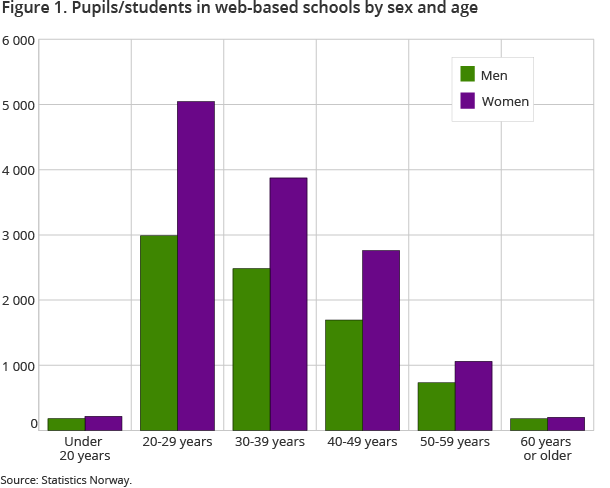Content
Published:
Updated:
This is an archived release.
The text was corrected and figure 2 (Share of completed courses, by sex and special field) was removed on 28 November 2014, due to an error.
One in four are women in their 20s
In total, there are 21 400 participants in web-based schools, of which women aged 20-29 make up 24 per cent. Men within the same age group constitute 14 per cent of the pupils/students.
| 2012-2013 | |||
|---|---|---|---|
| Completed educations | |||
| Total | Males | Females | |
| Corrected 27 November 2014. | |||
| Special field, total | 8 347 | 36 | 64 |
| General programmes | 748 | 36 | 64 |
| Humanities and arts | 626 | 25 | 75 |
| Education | 883 | 11 | 89 |
| Social sciences and law | 549 | 31 | 69 |
| Business and administration | 3 030 | 31 | 69 |
| Natural sciences, vocational and technical subjects | 545 | 51 | 49 |
| Health, welfare and sport | 775 | 9 | 91 |
| Primary industries | 3 | 0 | 100 |
| Transport and communications, safty and security and other services | 1 116 | 86 | 14 |
| Unspecified field of study | 72 | 39 | 61 |

Figure 1 shows that 20-29 year-olds constitute the largest age group at web-based schools , and that women are in the majority in all of the age groups. In total, women make up 61 per cent of the participants. There is also a large group aged 30 years or older, and these constitute 61 per cent of the participants.
Most course complettions in business and administration subjects
Twenty-six per cent of the 8 350 course completions for the school year 2012/13 were women under the age of 30, who completed most courses in 'business and administration subjects'. In total, there are also most course completions in business and administration subjects. Among the male participants, there were most course completions in 'transport and communications, safety and security and other services'. However there was also a big share of men who completed 'business and administration subjects'.
Most participants in upper secondary level
Web-based schools mainly offer education at upper secondary level, tertiary vocational level and university level. Seventy-one per cent of the participants attend courses at upper secondary level. There were also most course completions at upper secondary level; 66 per cent, compared to the other levels of education, while 25 per cent of the course completions were at university level.
Furthermore, three different learning methods are offered; location based, web-based without sessions and web-based with sessions. Most of the participants are in web-courses without sessions – 92 per cent. 73 per cent of these attend courses at upper secondary level.
NKI Fjernundervisning has most participants
'NKI fjernundervisning' is the largest web-based school measured by the number of participants, while 'NKS nettstudier' had the most course completions. All of the participants at 'NKI fjernundervisning' are in web-based courses without sessions and 80 per cent are studying at upper secondary level. There were 2 900 course completions at 'NKS nettstudier' and 1 900 course completions at 'NKI Fjernundervisning' in the school year 2012/13, of which 14 per cent at 'NKS' and 58 per cent at 'NKI ' were men.
This page has been discontinued, see .
Contact
-
Statistics Norway's Information Centre
E-mail: informasjon@ssb.no
tel.: (+47) 21 09 46 42
